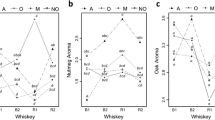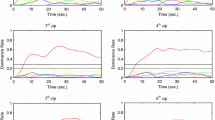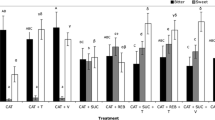Abstract
Beer is a complex beverage. Beer flavour is a multisensory experience in which, in addition to aroma volatiles, CO2, ethanol, bitterness (hop acids) and sweetness all contribute. To investigate the interactions between these fundamental components, a model beer system was developed using representative ingredients. Samples, selected according to a D-optimal design, were assessed by sensory profiling techniques by a trained panel. Predictive polynomial models generated from mean panel data described variations in the attributes as a function of design factors. Results show that CO2 significantly impacted on all discriminating attributes, including suppression of sweetness and modification of bitterness. A number of complex interactions with design factors showed the effects of CO2 to be dependent upon component concentration and level of carbonation. CO2 interacted with hop acids to increase carbonation and tingly perception, which increased linearly with hop acid addition but only at low levels of CO2. Ethanol was the main driver of warming perception and complexity. In agreement with other studies, ethanol enhanced sweet perception and also formed some complex interactions with hop acids and CO2 to modify various attributes, illustrating its ability to interact with both gustatory and trigeminal stimuli. Whether the mechanisms behind these interactions originate at the gustatory periphery or at higher centres in the brain is an area for further investigation. This study provides an in-depth assessment of important flavour components in beer and advances the limited data available on the effects of CO2 on sensory perception using a commonly carbonated beverage.






Similar content being viewed by others
References
Aznar M, Tsachaki M, Linforth RST et al (2004) Headspace analysis of volatile organic compounds from ethanolic systems by direct APCI-MS. Intl J Mass Spec 239(1):17–25
Bajec MR, Pickering GJ (2008) Astringency: mechanisms and perception. Crit Rev Food Sci Nutr 48(9):858–875
Brasser SM, Norman MB, Lemon CH (2010) T1r3 taste receptor involvement in gustatory neural responses to ethanol and oral ethanol preference. Phys Gen 41(3):232–243
Briggs DE, Boulton CA, Brookes PA et al (2004) Brewing science and practice. Woodhead, Cambridge
Carstens E, Kuenzler N, Handwerker HO (1998) Activation of neurons in rat trigeminal subnucleus caudalis by different irritant chemicals applied to oral or ocular mucosa. J Neurophysiol 80(2):465–492
Chandrashekar J, Yarmolinsky D, von Buchholtz L et al (2009) The taste of carbonation. Science 326(5951):443–445
Clark CC, Lawless HT (1994) Limiting response alternatives in time-intensity scaling—an examination of the halo-dumping effect. Chem Senses 19(6):583–594
Clark RA, Linforth R, Bealin-Kelly F et al (2011) Effects of ethanol, carbonation and hop acids on volatile delivery in a model beer system. J Inst Brew 117(1) (in press)
Cometto-Muniz JE, Abraham MH (2008) Human olfactory detection of homologous n-alcohols measured via concentration-response functions. Pham Biochem Behav 89(3):279–291
Cometto-Muniz JE, Garcia-Medina MR, Calvino AM et al (1987) Interactions between CO2 oral pungency and taste. Perception 16(5):629–640
Cowart BJ (1998) The addition of CO2 to traditional taste solutions alters taste quality. Chem Senses 23(4):397–402
Dessirier JM, Simons CT, Carstens MI et al (2000) Psychophysical and neurobiological evidence that the oral sensation elicited by carbonated water is of chemogenic origin. Chem Senses 25(3):277–284
Ellingson J, Silbaugh B, Brasser S (2009) Reduced oral ethanol avoidance in mice lacking transient receptor potential channel vanilloid receptor 1. Behav Gen 39(1):62–72
Fontoin H, Saucier C, Teissedre PL et al (2008) Effect of pH, ethanol and acidity on astringency and bitterness of grape seed tannin oligomers in model wine solution. Food Qual Prefer 19(3):286–291
Friel EN, Linforth RST, Taylor AJ (2000) An empirical model to predict the headspace concentration of volatile compounds above solutions containing sucrose. Food Chem 71(3):309–317
Goldner MC, Zamora MC, Di Leo LP et al (2009) Effect of ethanol level in the perception of aroma attributes and the detection of volatile compounds in red wine. J Sens Stud 24(2):243–257
Green BG (1988) Spatial and temporal factors in the perception of ethanol irritation on the tongue. Percept Psychophys 44(2):108–116
Green BG (1991) Capsaicin cross-desensitization on the tongue-psychophysical evidence that oral chemical irritation is mediated by more than one sensory pathway. Chem Senses 16(6):675–689
Green BG (1992) The effects of temperature and concentration on the perceived intensity and quality of carbonation. Chem Senses 17(4):435–450
Green BG, Hayes JE (2003) Capsaicin as a probe of the relationship between bitter taste and chemesthesis. Physiol Behav 79(4–5):811–821
Guinard JX, Souchard A, Picot M et al (1998) Sensory determinants of the thirst-quenching character of beer. Appetite 31(1):101–115
Hellekant G, Danilova V, Roberts T et al (1997) The taste of ethanol in a primate model. 1. Chorda tympani nerve response in Macaca mulatta. Alcohol 14(5):473–484
Hewson L (2007) Multimodal interactions in a carbonated beverage system. The University of Nottingham, Nottingham. PhD Thesis
Hewson L, Hollowood T, Chandra S et al (2008) Taste-aroma interactions in a citrus flavoured model beverage system: similarities and differences between acid and sugar type. Food Qual Prefer 19(3):323–334
Hewson L, Hollowood T, Chandra S et al (2009) Gustatory, olfactory and trigeminal interactions in a model carbonated beverage. Chem Percept 2(2):94–107
Hoopman T, Birch G, Serghat S et al (1993) Solute-solvent interactions and the sweet taste of small carbohydrates. 2. Sweetness intensity and persistence in ethanol water mixtures. Food Chem 46(2):147–153
Jones PR, Gawel R, Francis IL et al (2008) The influence of interactions between major white wine components on the aroma, flavour and texture of model white wine. Food Qual Prefer 19(6):596–607
Kappes SM, Schmidt SI, Lee SY (2006) Descriptive analysis of cola and lemon/lime carbonated beverages. J Food Sci 71(8):S583–S589
Keast SJR, Breslin PAS (2003) An overview of binary taste–taste interactions. Food Qual Prefer 14(2):111–124
Kiefer SW, Morrow NS (1991) Odor cue mediation of alcohol aversion learning in rats lacking gustatory Neocortex. Behav Neurosci 105(1):25–32
Langstaff SA, Lewis MJ (1993) The mouthfeel of beer—a review. J Inst Brew 99:31–37
Langstaff SA, Guinard JX, Lewis MJ (1991) Sensory evaluation of the mouthfeel of beer. Am Soc Brew Chem 49(2):54–59
Lawless H, Stevens DA (1984) Effects of oral chemical irritation on taste. Physiol Behav 32(6):995–998
Lederer CL, Bodyfelt FW, McDaniel MR (1991) The effect of carbonation level on the sensory properties of flavored milk beverages. J Dairy Sci 74(7):2100–2108
Lemon CH, Brasser SM, Smith DV (2004) Alcohol activates a sucrose-responsive gustatory neural pathway. J Neurophysiol 92(1):536–544
Lim JY, Green BG (2007) The psychophysical relationship between bitter taste and burning sensation: evidence of qualitative similarity. Chem Senses 32(1):31–39
Lyman BJ, Green BG (1990) Oral astringency: effects of repeated exposure and interactions with sweeteners. Chem Senses 15(2):151–164
Margolskee RF (2002) Molecular mechanisms of bitter and sweet taste transduction. J Biol Chem 277(1):1–4
Martin S, Pangborn RM (1970) Taste interaction of ethyl alcohol with sweet, salty, sour and bitter compounds. J Sci Food Agric 21(12):653
Mattes RD, DiMeglio D (2001) Ethanol perception and ingestion. Physiol Behav 72(1–2):217–229
McEvoy S (1998) Sensory evaluation of carbonated beverages utilizing a hyperbaric chamber or what would soda taste like if you could get inside the can? Chemical senses day XIV abstracts, Santa Rosa, CA
McLellan MR, Barnard J, Queale DT (1984) Sensory analysis of carbonated apple juice using response-surface methodology. J Food Sci 49(6):1595–1597
Medel M, Viala D, Meillon S et al (2009) A questionnaire for assessing the perceived complexity of wine: application to the study of the effect of expertise on perception of wine complexity. 8th Pangborn Sensory Science Symposium. Elsevier, Florence
Meilgaard MC (1982) Prediction of flavor differences between beers from their chemical-composition. J Agric Food Chem 30(6):1009–1017
Meilgaard MC, Dalgliesh CE, Clapperton JF (1979) Beer flavor terminology. J Inst Brew 85(1):38–42
Meillon S, Viala D, Medel M et al (2010) Impact of partial alcohol reduction in Syrah wine on perceived complexity and temporality of sensations and link with preference. Food Qual Prefer 21(7):732–740
Mintel Report (November 2009) Lager, UK
O’Rourke T (2002) Malt specifications & brewing performance. Brewer Int Tech Summ 2(10):27–30
O’Rourke T (2003) Hop and hop products. Brewer Int Tech Summ 3(1):21–25
Pozo-Bayon MA, Santos M, Martin-Alvarez PJ et al (2009) Influence of carbonation on aroma release from liquid systems using an artificial throat and a proton transfer reaction-mass spectrometric technique (PTR-MS). Flav Frag J 24(5):226–233
Prescott J, Swain-Campbell N (2000) Responses to repeated oral irritation by capsaicin, cinnamaldehyde and ethanol in PROP tasters and non-tasters. Chem Senses 25(3):239–246
Prescott J, Soo J, Campbell H et al (2004) Responses of PROP taster groups to variations in sensory qualities within foods and beverages. Physiol Behav 82(2–3):459–469
Ragot F, Guinard JX, Shoemaker CF et al (1989) The contribution of dextrins to beer sensory properties. Part I. Mouthfeel. J Inst Brew 95(6):427–430
Saint-Eve A, Deleris I, Aubin E et al (2009) Influence of composition (CO2 and sugar) on aroma release and perception of mint-flavored carbonated beverages. J Agric Food Chem 57(13):5891–5898
Scinska A, Koros E, Habrat B et al (2000) Bitter and sweet components of ethanol taste in humans. Drug Alcohol Depend 60(2):199–206
Shortreed GW, Rickards P, Swan JS et al (1979) The flavour terminology of Scotch whisky. Brewers’ Guardian 11:55–62
Simons CT, Dessirier JM, Carstens MI et al (1999) Neurobiological and psychophysical mechanisms underlying the oral sensation produced by carbonated water (vol 19, pg 8134, 1999). J Neurosci 19(22):10191–10191
Simons CT, Boucher Y, Carstens E (2003) Suppression of central taste transmission by oral capsaicin. J Neurosci 23(3):978–985
Smith JS, Hui YH (2004) Food processing: principles and applications. Blackwell, Oxford
Stone H, Sidel JL (2004) Sensory evaluation practices. Elsevier Academic Press, California
Talavera K, Yasumatsu K, Yoshida R et al (2008) The taste transduction channel TRPM5 is a locus for bitter-sweet taste interactions. FASEB J 22(5):1343–1355
Trevisani M, Smart D, Gunthorpe MJ et al (2002) Ethanol elicits and potentiates nociceptor responses via the vanilloid receptor-1. Nat Neurosci 5(6):546–551
Verhagen JV, Engelen L (2006) The neurocognitive bases of human multimodal food perception: sensory integration. Neurosci Biobehav Rev 30(5):613–650
Walters ED (1996) How are bitter and sweet tastes related? Trends Food Sci Technol 7(12):399–403
Wilson CWM, Obrien C, Macairt JG (1973) Effect of metronidazole on human taste threshold to alcohol. Brit J Add 68(2):99–110
Yau NJN, McDaniel MR, Bodyfelt FW (1989) Sensory evaluation of sweetened flavored carbonated milk beverages. J Dairy Sci 72(2):367–377
Acknowledgements
This work was carried out with the financial support from BBSRC and SABMiller.
Author information
Authors and Affiliations
Corresponding author
Rights and permissions
About this article
Cite this article
Clark, R.A., Hewson, L., Bealin-Kelly, F. et al. The Interactions of CO2, Ethanol, Hop Acids and Sweetener on Flavour Perception in a Model Beer. Chem. Percept. 4, 42–54 (2011). https://doi.org/10.1007/s12078-011-9087-3
Received:
Accepted:
Published:
Issue Date:
DOI: https://doi.org/10.1007/s12078-011-9087-3




